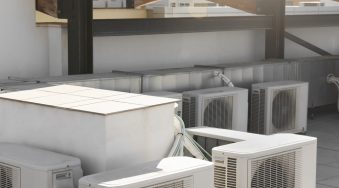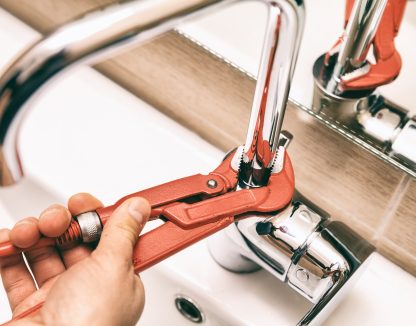Running an HVAC (Heating, Ventilation, and Air Conditioning) business can be a highly lucrative venture, but it comes with its own set of challenges, particularly when it comes to setting your own salary as the business owner. Unlike being an employee, where a fixed paycheck arrives every month, as a business owner, your income depends on various factors, including the financial health of your business, industry trends, and your strategic decisions.
In this blog post, we’ll explore the dynamics of setting an HVAC business owner’s salary and how to create a profitable payroll structure that ensures your business thrives while you enjoy the financial rewards.
Ready to Learn More?
Tips for Calculating Your HVAC Business Owner Salary
Calculating your HVAC business owner’s salary can be a complex task, as it involves various financial factors and considerations. Here are some tips to help you determine a fair and profitable salary for yourself as an HVAC company owner:
1. Understand Your Business Finances
Before deciding on your salary, have a comprehensive understanding of your business finances. This includes revenue, expenses, profit margins, and cash flow. Clear financial insights will guide your decision-making process.
2. Determine Minimum Personal Expenses
Calculate your personal financial needs. This includes covering essential living expenses such as housing, groceries, transportation, insurance, and any other regular bills. Determine the minimum amount required for your personal financial security.
3. Account for Business Expenses
Ensure your salary covers your personal expenses and any business-related expenses directly tied to your role as the business owner. This may include health insurance, retirement contributions, or vehicle expenses if you use your personal vehicle for business purposes.
4. Review Industry Standards
Research industry standards and average income for HVAC business owners. This can provide a reference point for what others in similar roles and industries are earning.
5. Consider Business Profitability
Your salary should be based on your business’s profitability. Ensure that your business is consistently generating a healthy net profit after covering all operational expenses. Your salary should not jeopardize the financial stability of your business.
6. Balance Business Growth and Personal Income
Strive to balance your need for personal income with the financial needs of your business. Reinvesting profits into the business for growth and emergencies is crucial for long-term success.
7. Incorporate Tax Considerations
Consult with a tax professional to understand the tax implications of your salary. Different structures, such as S corporations or sole proprietorships, can affect your income and tax liability.
8. Review Cash Flow
Consider your business’s cash flow. A steady, positive cash flow is essential to ensure that your salary can be paid consistently. Monitor your cash flow to avoid cash shortages.
9. Adjust Regularly
Be prepared to adjust your salary as your business evolves. During periods of growth or economic downturns, your salary may need to be adjusted to reflect the changing financial circumstances.
10. Consult with Financial Advisors
Seek the guidance of financial advisors or accountants who specialize in small businesses. They can help you make informed financial decisions and optimize your salary structure.
11. Establish a Written Compensation Plan
Consider creating a written compensation plan for yourself, as well as your HVAC technicians, that outlines salary details, benefits, and any performance-based bonuses.
12. Factor in Economic Trends
Stay informed about economic and industry trends that may impact your business’s profitability. External factors can influence your ability to pay yourself and your employees a competitive salary.
13. Prioritize Long-Term Financial Security
Along with your salary, plan for long-term financial security by contributing to retirement accounts and creating an emergency fund. Financial stability will enable you to weather challenges and seize opportunities.
Tips for Increasing Your Profit Margins
Increasing profit margins in your HVAC business involves optimizing your operations, pricing strategies, and cost management. Here are some tips to help you enhance your profit margins:
1. Evaluate Pricing Strategies
Review your pricing structure. Ensure that your pricing covers both direct and indirect costs, including labor, materials, overhead, and desired profit. Consider value-based pricing by highlighting the benefits of your HVAC services.
2. Cost Reduction
Regularly assess your expenses and identify areas where you can cut costs without compromising the quality of your services. This may include negotiating better supplier deals or finding more efficient equipment.
3. Streamline Operations
Implement efficient processes and workflows. Optimize scheduling, dispatch, and job tracking to reduce operational inefficiencies and minimize downtime. Automate administrative tasks like invoicing, billing, and appointment scheduling to reduce labor costs and minimize errors.
4. Service Diversification
Expand your service offerings to include higher-margin services such as maintenance contracts, energy-efficient upgrades, and indoor air quality solutions. Cross-selling these services to existing customers can increase your overall profit.
5. Regular Maintenance
Perform routine maintenance on your equipment to extend its lifespan and reduce repair and replacement costs. This also minimizes downtime, allowing you to take on more jobs.
6. Staff Productivity
Ensure that your team is productive by providing adequate training and tools. Well-trained technicians can complete jobs more efficiently, allowing you to serve more clients.
7. Customer Relationship Management
Build and maintain strong relationships with your customers. Satisfied customers are more likely to return and refer your services to others, reducing marketing expenses and increasing revenue.
8. Regular Price Reviews
Review your pricing structure regularly to keep up with market changes and cost fluctuations. Don’t be afraid to adjust prices to reflect the current economic climate.
9. Negotiate Supplier Contracts
Negotiate with suppliers to secure favorable terms and pricing for materials and equipment. Building long-term partnerships with reliable suppliers can lead to tool and equipment cost savings.
10. Digital Marketing
Invest in digital marketing to reach a wider audience and reduce traditional advertising expenses. An effective online presence can attract more customers and improve brand visibility.
11. Scheduling Efficiency
Optimize your scheduling and dispatch system to reduce travel time and increase the number of service calls your technicians can handle in a day.
12. Maintenance Agreements
Encourage customers to sign maintenance agreements. These agreements provide a steady source of income and ensure that systems are regularly serviced, preventing costly repairs.
13. Cost Allocation
Review your business expenses to ensure costs are appropriately allocated to specific jobs and projects. This helps you determine the profitability of each service.
14. Employee Training
Invest in ongoing employee training to keep your team up to date with the latest HVAC technologies and best practices. Well-trained technicians are more efficient and can handle complex jobs.
15. Employee Retention
Reducing staff turnover can save you money on recruitment, training, and onboarding costs. Provide a competitive salary, benefits, and a positive work environment to retain top talent.
16. Market Research
Stay informed about market trends and customer preferences. Adapting your services to meet changing demands can attract more customers willing to pay for your specialized solutions.
By implementing these strategies and continually monitoring your financial performance, you can increase your HVAC business’s profit margins, ultimately leading to greater financial stability and success.
HVAC Payroll Best Practices
Certainly, managing payroll effectively is crucial for HVAC contractors to ensure smooth operations and compliance with labor laws. Here are some HVAC payroll best practices to consider for your blog:
1. Accurate Record Keeping
Ensure you maintain accurate records of employee hours worked, overtime, paid time off (PTO), and other relevant information. Utilize electronic time-tracking systems to minimize errors and ensure compliance.
2. Compliance with Labor Laws
Stay up-to-date with federal, state, and local labor laws, including minimum wage, overtime, and payroll tax regulations. Non-compliance can lead to costly penalties.
3. Classify Workers Correctly
Properly classify employees and independent contractors. Misclassifying workers can lead to legal issues and back taxes. Consult with legal or HR experts if you’re unsure about classifications.
4. Overtime Management
Implement clear overtime policies and pay overtime as required by law. Track employee hours accurately and use software that can automatically calculate and manage overtime pay.
5. Payroll Software
Invest in a reliable payroll software or outsource your payroll to a trusted provider. These tools can automate calculations, tax withholdings, and other payroll processes, saving time and reducing errors.
6. Direct Deposit and Electronic Pay Stubs
Offer direct deposit options to employees and provide electronic pay stubs. This reduces administrative work and ensures employees have easy access to their pay information.
7. Regular Payroll Audits
Conduct periodic audits of your payroll records to identify and rectify errors or discrepancies promptly. This will help maintain accuracy and compliance.
8. Employee Training
Train your staff, including HR personnel, on payroll best practices and compliance requirements to reduce errors and ensure everyone understands their responsibilities.
9. Track Paid Time Off (PTO)
Implement a system for tracking and managing paid time off, such as vacation, sick days, and holidays. Ensure employees receive the appropriate PTO benefits.
10. Stay Organized
Maintain a well-organized payroll system with clear documentation, including employee contracts, tax forms, and payroll reports. This will be helpful for audits and record-keeping.
11. Record Retention
Understand and comply with regulations regarding how long you should retain payroll records. Different types of records may have different retention periods.
12. Communication
Open lines of communication with your employees regarding their pay, benefits, and any changes in payroll processes. This transparency can help prevent misunderstandings and disputes.
13. Emergency Fund for Payroll
Consider setting aside an emergency fund to ensure you can meet payroll in case of unexpected financial challenges.
Remember that payroll management is a critical part of your business, and getting it right not only keeps your employees happy but also helps you avoid legal issues. These best practices will help you navigate the complexities of payroll in the HVAC contracting industry.
HVAC Business Owner Salary Frequently Asked Questions
What is the average HVAC owner’s salary?
The average salary for an HVAC (Heating, Ventilation, and Air Conditioning) owner can vary significantly depending on factors such as location, business size, and experience. However, as of September 2021, the average salary for an HVAC business owner in the United States ranged from $50,000 to $100,000 per year. It’s important to note that this figure may have changed since then.
How can an HVAC owner increase their salary?
An HVAC owner can increase their salary by implementing several strategies:
- Expand Services:
Offer additional services like energy-efficient upgrades, air quality solutions, or smart home integration to attract more customers and increase revenue streams.
- Improve Efficiency:
Streamline operations, reduce waste, and optimize scheduling to increase job throughput and profitability.
- Continual Training:
Stay updated with industry trends, new technologies, and certifications. This can lead to higher-paying projects and better customer trust.
- Effective Marketing:
Invest in marketing efforts to increase visibility and attract more clients. Utilize online platforms, social media, and local advertising.
- Excellent Customer Service:
Provide exceptional service to build a strong reputation and encourage repeat business and referrals.
- Pricing Strategy:
Regularly review pricing structures to ensure they are competitive but still allow for a healthy profit margin.
- Cross-Selling and Up-Selling:
Recommend complementary services or upgrades to existing clients, increasing the overall revenue from each project.
- Efficient Financial Management:
Keep a close eye on expenses, manage cash flow effectively, and explore cost-saving measures.
- Diversify Revenue Streams:
Consider branching into related areas like plumbing or electrical services, or explore commercial HVAC contracts.
- Leverage Technology:
Utilize software and tools to streamline administrative tasks, manage appointments, and track finances.
- Build a Strong Team:
Hire skilled technicians and provide ongoing training. A capable team can handle more projects, leading to increased revenue.
- Network and Partnerships:
Build relationships with suppliers, contractors, and industry peers. This can lead to cost savings, referrals, and potential collaborations.
- Monitor Industry Trends:
Stay informed about emerging technologies and industry shifts. Being an early adopter can give your business a competitive edge.
- Quality Assurance:
Ensure consistently high-quality work to build trust with clients, leading to repeat business and positive reviews.
Remember, it’s important to balance increasing revenue with managing costs and maintaining quality. Finding the right mix for your specific business is key to sustained success.







